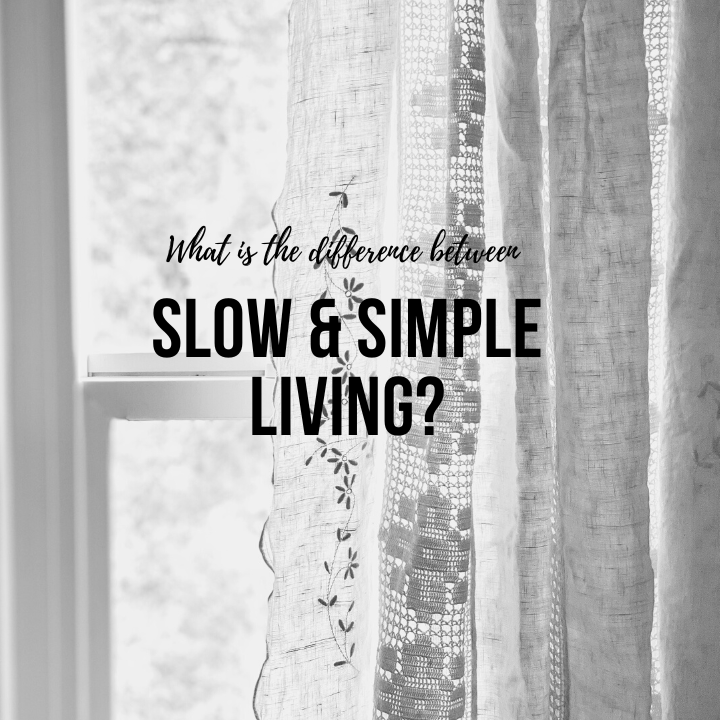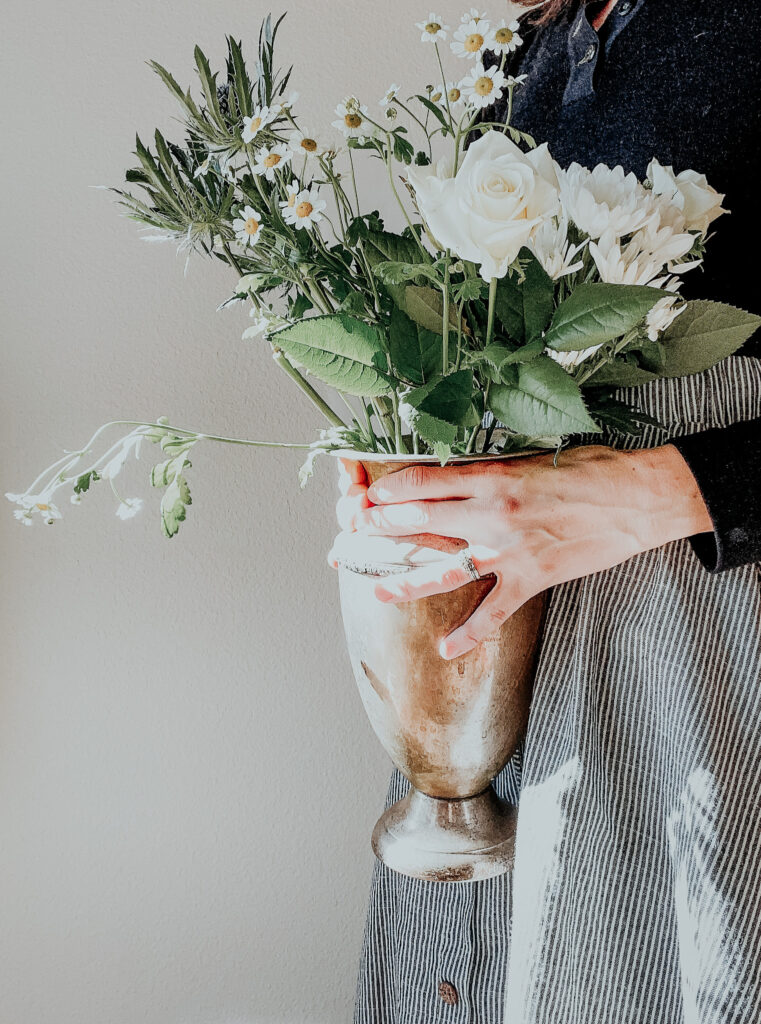What is the difference between slow and simple living?
You may wonder, what is the difference between slow and simple living? Aren’t they the same thing? For a long time, I thought slow living and simple livening equated to the same lifestyle. As I dug deeper into the trends, I discovered that they share a lot of commonalities while retaining a few key differences. Let’s dive into the concepts together.
“Slow living isn’t about determining how little we can live with – it’s about working out what we simply can’t live without.”
Nathan Williams

What is Slow Living?
Slow living is a lifestyle that encourages mindfully doing less so you have more time to intentionally focus on what is the most important.
It’s not necessarily about living at a slower pace or doing your daily tasks slowly. Instead, slow living is a rejection of the hustle mentality and the idea that pushing and striving will bring you what you desire most.
Slow living creates more time to do the things you find ease, enjoyment, and alignment by removing or saying no to the things, people, and tasks that don’t align with your greater values. It’s more about taking your time to intentionally choose how and where your time (your most precious commodity) will be spent. This lifestyle also values sustainability and quality over quantity.
Slow Living can look like the following:
- Choosing a less stressful job over a position with a higher stress level.
- Mending your favorite pair of jeans instead of purchasing a new pair.
- Supporting local farmers’ markets.
- Spending most of your time with people who bring you joy.
- Having clear and kind boundaries with people, places, and activities that don’t bring you joy.
- Enjoying home-cooked meals and saving money to spend at your favorite restaurant intermittently.
- Growing flowers, vegetables, herbs, and fruits in small gardens or containers.
- Living Seasonally.
- Choosing to make gifts using high-quality and sustainable materials and ingredients.
- Learning art forms that take time, like quilting or weaving.
- Choosing to walk instead of drive.
- Reducing your time on devices or taking a technology Shabbat.
What Slow Living Isn’t About
Slow living isn’t about spending extra time on every task or taking longer to make decisions. It’s not about leaving behind all modern conveniences or becoming a hermit in the hills. Instead, think of slow living as a lifestyle and mindset. One where you intentionally create a life based on what you value most. It’s about living better, not faster-and environmentally aware.
How Slow Living Can Help You Live More Sustainably
Ultimately, slow living is about opting out of the fast, quick, and consumable mindset of modern living in a capitalistic world with the intent to make decisions more consciously. Changing your status of “I don’t have time” to transitioning to intently selecting where and how your time is spent. Making decisions from a place of intention allows for more time to plan and think more sustainably.
This can look like choosing to cook from scratch and using less processed ingredients. By effect, you end up purchasing food that is less packaged and seasonal. The positive aspects of this choice is you are consuming fewer preservatives, eating fresher food, and perhaps even supporting your local farmers by shopping farmers’ markets or from locally owned markets.

What is Simple Living?
Simple living promotes frugality and living with fewer possessions.
While slow living is often associated with the unbusy movement, simple living is a closer cousin to the minimalist movement. Simple living is more about intentionally choosing to live with less or living in ways associated with being frugally minded.
The main goal behind simple living is to keep one’s life and living spaces uncomplicated, decluttered and kept to the basics. It can also mean detaching from greater society to remove the pressure of increasing income to keep up with increased lifestyle demands, such as the desire for a bigger home, nicer car, or expensive vacations.
Simple Living can look like the following:
- Living off the grid.
- Homesteading and producing much of your food.
- Reducing consumption of commercial goods.
- Choosing to live in a smaller space intentionally, like a tiny home.
- Opting out of high-paying jobs and professions.
- Choosing to live or spend more time in nature.
- Choosing to use and engage with less technology.
- Making food from scratch, like baking bread from homegrown wheat.
- Eating simpler foods and meals.
- Using free time to pursue creative endeavors or volunteer in the community.
- Making your clothing using fabrics and materials you have on hand.
- Living simply to use funds to travel lightly, like backpacking or staying in hostels.
What Simple Living Isn’t About
There are many different degrees of simple living, and just like slow living, anyone can take the way of living to an extreme. Overall, simple living is not like minimalism, but a minimalistic mindset is valued. Simple Living is also not explicitly associated with one group of people or one religion. Different religions, such as Buddhism and the Quaker Movement, have adopted the concept through the ages, but anyone can choose to live a simpler life.

How Does Simple Living Help The Environment?
Simple living also values self-reliance, self-sufficiency, and preparedness but doesn’t necessarily intentionally seeks to have a low carbon footprint or a desire to support environmentalism. Simple living can positively affect the environment, as fewer chemicals, packaging, and material goods are often needed for this lifestyle.

How Can Slow and Simple Living Benefit Your Health?
Both living slowly and simply can have numerous benefits to your health. Living with less stuff to manage and maintain can reduce the feelings of overwhelm and lower anxiety and stress. You can intentionally spend your time on activities that have more positive health benefits, such as exercise, meditation, time in nature, and eating a healthier diet.
According to The American Institute of Stress, “Stress can cause high blood pressure and heartbeat irregularities,” Dr. Ross tells Bustle. Being stressed is a risk factor for poorer heart health overall, with stressed people more likely to show symptoms of cardiovascular disease, heart attacks, and other heart issues over the course of their lifetimes.
Is there a downside to seeking a slow and simple stress-free life?
There is also recent research on the benefit of small amounts or intentional amounts of stress in life. Penn State recently studied the benefits and also the downside of living or seeking a completely stress-free life. The study’s main takeaway determined that people who reported experiencing no stressors were more likely to experience feeling an overall better state of well-being and fewer chronic health conditions. However, they also were more likely to experience lower cognitive function.

Is it possible to live simply and slowly?
Is it possible to live and slowly? Yes! Like anything in life, multiple variations of lifestyles and preferences exist. It’s likely that if you choose to live, you will also fulfill the qualities of living a slow life too.
What’s the best way to get started living slowly and simply?
The best way to start with introducing the concepts of slow or simple living to your life can be broken down into just a few steps. In many ways, it’s easier to start with the intention to slow down, and once you have the hang of living with more intention, you will have more confidence in approaching life more simply.
How to live more slowly
- First, identify your significant values. This will help you clarify what’s most important to you and set the framework for starting to live slowly.
- Begin living your life based on your values and applying your slower intentions to your every day.
- Practice, practice, practice, and then practice some more. The more you practice implementing your slow mindset, the more you will experience the benefits of slower living.
- Enjoy the benefits of more time to do the things that light you up.
Further Inspiration to Live Slowly
Join the 7-Day Hygge Challenge
How to Buy Land to Homestead-5 Things to Consider (A City-Slicker’s Guide)
